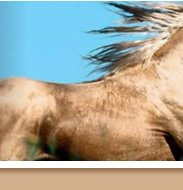![]()
![]()
![]()
![]()
![]()
![]()

![]()
![]()
![]()
![]()
![]()
Starting Young Horses at StartSmart AcademyAn exclusive report about the first session of StartSmart Academy, the young-horse starting program at Judi Gerhardt's Blue Moon Equestrian Center in Covington, Louisiana.By Judi Gerhardt StartSmart Academy founder Judi Gerhardt (at left) presents a three-year-old filly for the entrance evaluation and vet assessment to lead trainer Helmut Schrant (center) and Dr. Gary Greene (right). StartSmart Academy's inaugural three-month session (January to April 2004) provided a wealth of data for the continued evolution of this young horse starting program. We successfully met our goal -- to begin to develop a standard for progressively starting young American sport horses. Participating in this first-of-its-kind-in-the-US program were four three-year-olds, four four-year-olds and three five-year olds. Eight of the 11 youngsters had never been backed, while three had experienced minimal backing elsewhere. All the horses were American-bred/born and held papers from one of the sporthorse federation member registries. Related Resources # Make Every Moment a Time to Train # Beeman on Training # Training and Behavior Articles A cornerstone of the program is attention to the individual horse -- its mental and physical development and its personality. This was provided by veterinarian Dr. Gary Greene, myself, and lead trainer Helmut Schrant. We were able to collect information throughout the program on each horse via veterinary assessments, evaluations by Schrant, rider scoring and daily management monitoring. This information not only defined the specific needs of each horse for the duration of the program, but it will also provide owners with a basis for future reference as each horse continues its career. One very important part of the program that was modified during the vet assessments was the guide Dr. Greene developed. In discussions prior to the launch of the program, Dr. Greene and I thought we had analyzed and finalized the items to be considered for each of the three vet exams. However, as the first evaluations began we all realized that we wanted to and could record even more valuable information. We assessed all horses with the expanded list of items and now have consolidated a truly thorough guide of physical attributes by which to evaluate the horses in future sessions. The entrance vet assessment includes a health history; body condition score; check of heart, lung, eyes and mouth; a detailed listing of conformation items; detailed analysis of limbs -- joints, tendons, hooves. Then we recorded observations of movement (walk/trot) in-hand. Temperament was also scored by the veterinarian, trainer and barn manager. All of this was re-evaluated after 45 days under saddle and again at the conclusion of the program -- with the horse's movement also observed and noted while under saddle. Videotapes and still photographs were taken of each horse's examinations, as well as randomly while working throughout the program. Riders worked with each horse six days a week and scored each one every day on character, temperament, ability to work, willingness to work and ride-ability. Two riders initially worked together in the round pen with each youngster, longeing first without and then with a rider. The initial riding was done by the same rider. As the horse progressed and became more confident the riders would alternate their horses if appropriate, as well as take them outside on the trails and share in the grooming. Free-jumping was introduced as a recreational activity and change of pace. A final video was made of each horse being ridden inside and outside. The riders provided an overview of what to expect and the level of work to continue with. Owners were offered time with the riders and horse at the end of the program, however, none of their schedules allowed for them to come and ride their horse at the end of the session. Helmut travels frequently between the U.S. and his native Germany. Regular conference calls and videos enabled him to keep up with the progress of the horses. The bump in the road to completing our session almost flawlessly was me! As administrator for this first session I generated copious forms and drafts and copies. Compiling the information was easy and a real learning experience as I dealt with unreliable technology. Again, having gone through the process we know the paper part of it will improve. The mission of StartSmart Academy, to merge two equestrian cultures to provide a progressive, systematic gymnasticizing start for young American sport horses, was accomplished for these few youngsters. The process has been a start... a smart start, we hope. The fall session will begin October 1, 2004. Looking at the mountain in the rearview mirror is a delightful perspective -- it doesn't look so impossible after all and makes the journey forward much more enticing. Read leading U.S. dressage trainer Scott Hassler's column on the need for programs targeted to young sporthorses in the July 2004 issue of Practical Horseman magazine. |
![]()
![]()
ęCopyright 2025
Alhaja.net All rights reserved.
Unauthorized duplication in part or whole strictly prohibited by
international copyright law.
![]()



